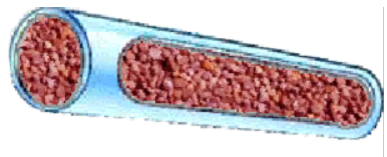Innovations in Pneumatic Conveying Technology
Which is a better choice between dilute and dense phase?
Although there is lot of information online, when it comes to making a decision between dilute phase and dense phase pneumatic conveying system there is always an underlying confusion. Uncertainty arises in someone’s mind due to unclear guidelines while making a selection as there is no clear formula to choose between the two. So, we will take you through a stepwise selection approach which will definitely give you a clarity to make a better selection.
Step 1: Clear understanding between dilute and dense phases
What do you exactly mean by dilute and dense?
Let us first understand the types of pneumatic conveying system. Conveying systems are broadly differentiated on the basis of conveying flow behavior inside the pipe cross-section as dense and dilute phases.

Solid Dense Phase

Discontinuous Dense Phase

Continuous Dense Phase

Dilute Phase
When materials are conveyed in batches with lower air velocities and higher conveying pressure, the system is called as Dense phase pneumatic conveying system. Generally, Velocity of air up to 3-14m/s is used. Dense phase systems slowly convey powder which makes it more material- friendly. In dense phase conveying, the material is pressurised with the help of air and then the material and air mixture is conveyed through pipelines.
In dilute phase pneumatic conveying, the material is conveyed in suspension in the pipeline with the help of air. Velocity ranging from 18-35m/s can be used. The dilute phase systems are again classified as positive pressure and vacuum operated systems based on the application as well as the type of powder that is to be conveyed.
Below mentioned are typical parameters used in Dense and Dilute phase (Conveying systems being material specific the mentioned values can have certain exceptions)
| Parameters | Dense phase | Dilute phase |
|---|---|---|
| Air velocities | 3m/s-14m/s | 18m/s-35m/s |
| Air volume | Low | High |
| Material to air Loading ratios | Generally above 10 | Generally, up to 10 |
| Pressure ranges | High pressure above 1 bar | Low pressure below 1 bar |
Step 2: Material characteristics
While selecting the optimized system for pneumatic conveying the most important factor on which emphasis needs to be given is material characteristics. Physical as well as chemical characteristics of the material highly influence the selection of the systems. The materials can be characterized as abrasive, fragile, hard, electrostatic, low density etc. .
The table below recommended method of conveying to be used based on the material properties.
| Characteristics | Description | Conveying phase preferred |
|---|---|---|
| Abrasive | Materials which have sharp edges and that can abrade or wear down the other material which comes in contact with them. | Dense |
| Fragile | Materials that can be easily broken or damaged are called as fragile materials. | Dense |
| Low density | The materials which are light in weight and needs more volume to occupy themselves. | Dilute |
| Electrostatic | The materials that can produce electric charge while conveying are called as electro- static materials | Dense |
Although there is no such definition in pneumatic conveying which states which material can only be conveyed using a specific phase but following table shows list of materials which are predominantly conveyed in pneumatic conveying systems and recommendations on the phase in which they can be conveyed in optimized manner.
| Material | Conveying phase preferred |
|---|---|
| Cement | Dense |
| Bentonite | Dense |
| Quartz | Dense |
| Fly ash | Dense |
| Alumina | Dense |
| Coal | Dense |
| Ceramic | Dense |
| Talc | Dilute |
| Lime | Dense or Dilute |
| Sugar | Dilute |
| HDPE powders | Dilute |
| Pellets | Dense or Dilute |
| Bleaching earth | Dilute |
| Coffee beans | Dense or Dilute |
| Soda ash | Dense or Dilute |
Step 3: System configuration
System configuration also plays a decisive role in selecting the conveying system. The system configuration includes –
- Conveying distance
- Conveying capacities
- Conveying pressure
- Air volume
While going for dense or dilute phase pneumatic conveying, one should focus on the system configuration. The selection must be based on the all the above parameters. The table below shows typical parameters which can help in getting a general idea of selection.
| Parameters | Dense | Dilute |
|---|---|---|
| Conveying distance | 150 meters or more | Preferably Up to 150 meters |
| Conveying capacities | More than 10TPH | Less than 10TPH |
| Conveying pressure | More than 1 bar | less than 1 bar |
| Air volume | Less | More |
Step 4 : Economics of operation
The final step in choosing the appropriate system for conveying can be Economics of operation. Both the systems have certain boundaries under which they give the most economical results.
Prima facie one can conclude that the dilute phase is more economical since it has comparatively less initial investment but it has certain limitations as well. The dilute phase can be economical only when conveying the materials at lower conveying rates and distances but as the distances and conveying capacities of the system increases the dense phase becomes more economical because of lower air volume requirement. Therefore, while choosing the right method for conveying one should consider all the above mentioned factors.
If every step is understood and followed, one can understand the basic difference between the two phases which will help them to choose the most suitable phase for conveying the material.
